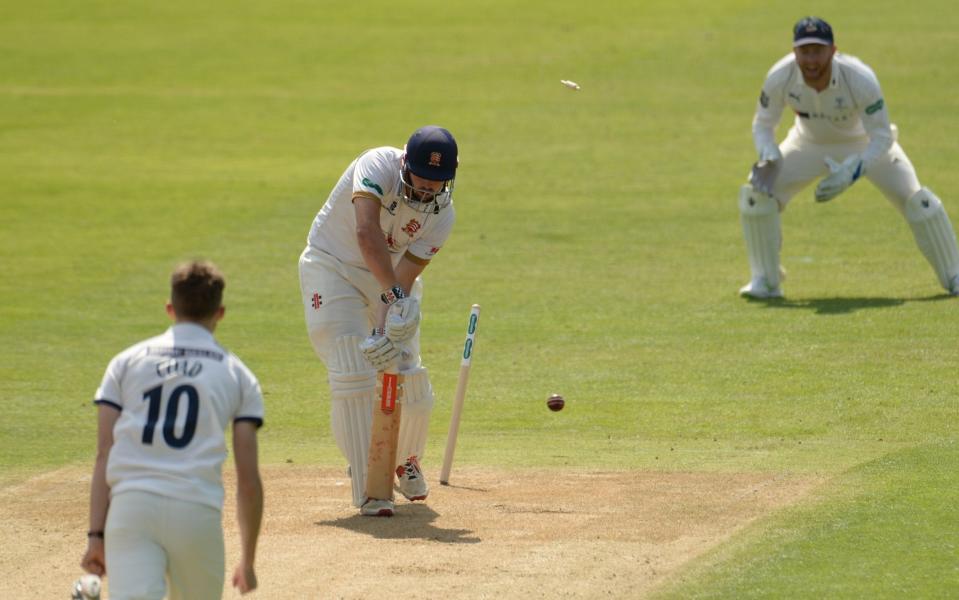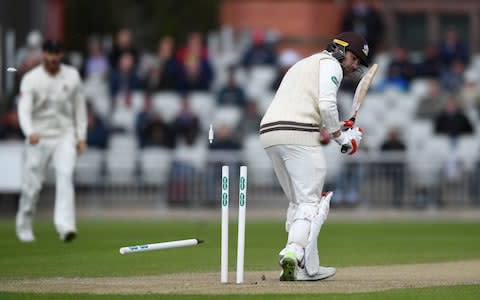Special report: Why are scores in the County Championship plummeting?

The second part in a series of special reports on the domestic game investigates why scores in the County Championship are getting worse year on year...
It is a warm, sunny, late-March morning and Derbyshire are preparing for the new season. Mal Loye, the county’s assistant coach, is crouching down trying to reach a ball that has been hit under a temporary stand.
A lot of balls have disappeared into the seating areas in pre-season matches over the past week as games against students and friendlies between counties have been dominated by big scores.
But they cannot hide the fact batting in the Championship, which starts on Friday, has become a desperately difficult job in recent years, making it harder than ever for England to unearth Test batsmen.
Not since Joe Root established himself in the side has a specialist batsman broken through for England. But is it any wonder when you look at the scores in county cricket where, in 2018, only five players made more than 1000 runs, 22 fewer than five years previously, and the average innings total was just 291.
Wayne Madsen has batted in county cricket for 10 seasons for Derbyshire and needs little prompting to reveal how difficult the job has become. “There were a lot of games last year when we thought if you scored 200 in the first innings you were in the game, 250 and you would probably win. In the past you would look at 350 or 400 but that has come down drastically because there is always a ball you feel will get you out.”

Kent veteran Darren Stevens first played Championship cricket in 1997, the year before Sam Curran was born, and has never found it a tougher time to bat, and not just because he is 42 and preparing for a season in Division One. “I played on one flat pitch all season last year at Warwickshire and even Lord’s was a minefield. I reckon I felt ‘in’ probably only twice.
“I saw Tom Westley (Essex) recently and asked him the difference between the First and Second Division. He said the First Division is an off-side game where bowlers bowl in the channel outside off stump and you have to be patient. In the Second Division it is a straight game, you play on the leg side because bowlers are looking to use the movement off the pitch to hit you on the pads or bowl you through the gate. The Second Division is a farce. Bowlers might love it but batters are not going to stay around on those pitches. Teams make pitches green and back their own bowlers.”
Bowlers like Stevens, who has no pace to speak of but took 42 wickets last season at 19 each, cannily using the pitches to his advantage. The county ‘trundler’ is still a respected weapon, despite the attempt to sideline them by abandoning the toss to encourage better pitches. Daryl Mitchell, of Worcestershire, believes all it has done is force counties to prepare pitches that stay green for the whole game instead.

Telegraph Sport revealed the results of an exclusive survey of county chief executives which revealed almost unanimous agreement that the Championship has been marginalised by the schedule. Matches played in April in swinging conditions, or in September on tired pitches, have made batting a lottery at times.
“It has got to be mental,” said Stevens.”When was the last time players churned out a hundred from 270 balls? I bet they mostly go along at a strike-rate of 80 now. Players see a few whizz past the outside edge and think, ‘I’m not doing this’. So they go hard at it.”
It has prompted the ECB to make changes this year to help redress the balance. More games will be played in the height of summer, with three rounds in July, but the use of more out-grounds, where pitches can be lively, could negate that tinkering with the fixture list. The heavy roller has been brought back. Teams are now allowed to use it once in the match which will help iron out indentations on damp pitches that cause uneven bounce. The seam on the Duke ball is slightly smaller, too, and match referees can now punish pitches for ‘excessive seam’ movement.
“Last year even when I got to a hundred I was playing and missing. Normally if you get in you are pretty well set. It is you who makes the mistake rather than being got out. But last year you could nick any ball or it could dart in and hit you on the pads,” said Mitchell.

“Over the last two years I have set my game around making the most of getting in. For example, two summers ago I got 1,200 runs and averaged the best part of 60 but only reached 20 12 times and made less than 20 13 times so I failed more than I succeeded even in a really good year but fortunately I managed to go on and make hay when I got in. “
Madsen and Mitchell are county pros that have seen it all, particularly the technique and mentality changes in younger players who see Twenty20 as the road to riches even though Mitchell, as the Professional Cricketers’ Association chairman, has helped negotiate a new salary collar next year of £1.3 million that will see his members get a pay rise.
Madsen has just returned from the Pakistan Super League where his team, Peshawar Zalmi, reached the final in Karachi. He can understand why younger players base their games around earning contracts in those leagues, neglecting the harder job of grinding out runs on county green tops.

“It is hard for the younger batters,” he says. “It is something we talked about over the winter, trying to take games four days. Last year our average game lasted 2.7 days. This year we want to take games longer than that. The batting discipline is what we have to keep improving and instilling in our younger cricketers. They have been moved away from the defensive part of the game by T20 so we are trying to get our younger players to understand there are times when your defence is crucial.”
Paul Grayson is the new batting coach at Yorkshire, tasked with helping players adapt between formats. “Young batsmen want to be good at T20 cricket for two reasons. The excitement of the game, the big crowds and clearly the money. The skill and mentality for that is to hit the ball, get on with it and you can’t afford dot balls. It is difficult then to switch back to having to actually bat for two hours against the moving ball. It is about having the patience, desire and will to do that. The biggest threat to our four-day cricket is players thinking, ‘sod that, I want to just be really good at T20 so I can make my fortune’.”

Are batsmen mentally weaker? Or is it more complicated than that and it is about identity? “Young players try to express themselves more and stamp their impression on the bowler,” says David Sales, the Northants batting coach. “It is like, ‘I am here what have you got’. Perhaps people kept their heads down and got on with it in the past. The biggest thing these days is you need to know your strengths and be open to your weaknesses. Nobody likes to admit these things but if a player can admit the areas they are vulnerable in and start to work on them, then they can be successful.”
Cricket is a batsman’s game. Always has been. But what about the bowlers? “As a seamer it is great. But there is added pressure because you have to perform on wickets that aid you,” said Jack Brooks, who moved from Yorkshire to Somerset during the winter. “Is it a good thing? If you go up to Test level the wickets are flatter and a bit quicker and suddenly young seamers have to work out how to get batters out rather than rely on the pitches.
“White ball is a batsman’s game. It has to be for entertainment value. But red-ball cricket in this country is a seamer’s game which helps bowlers like me who have made a career out of it. It is weird how different white and red-ball cricket are. It is like T20 is a different sport altogether now.”

